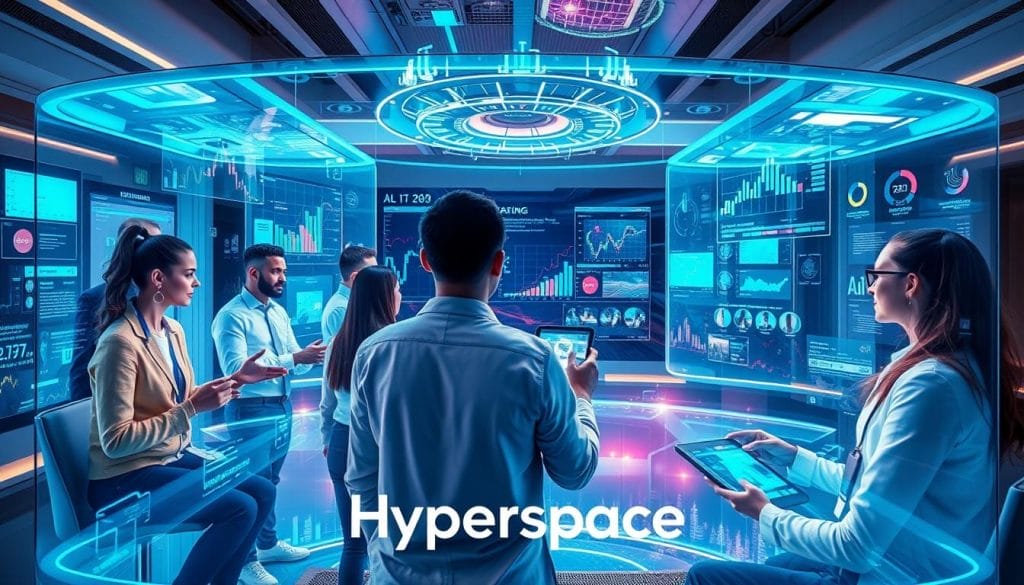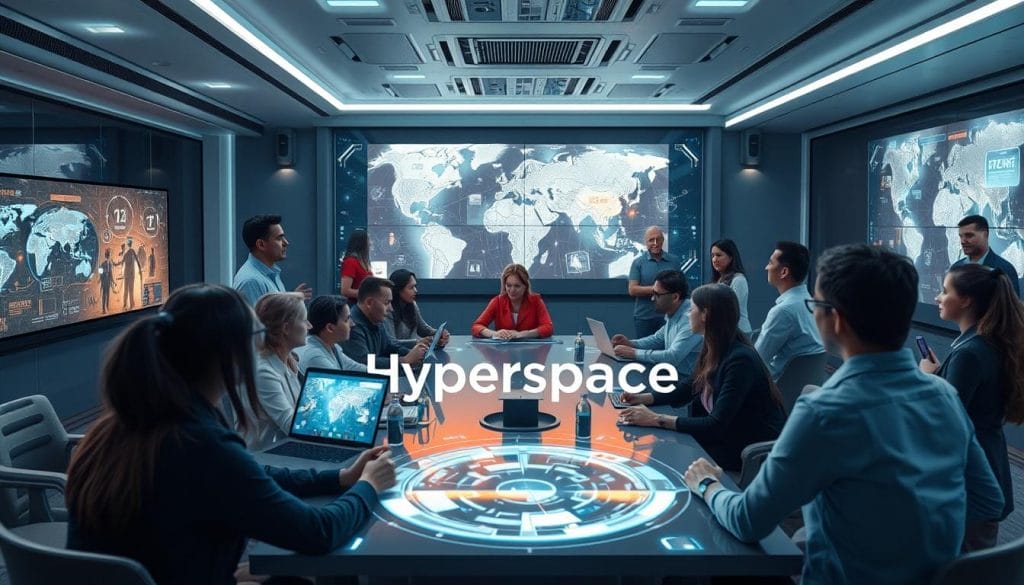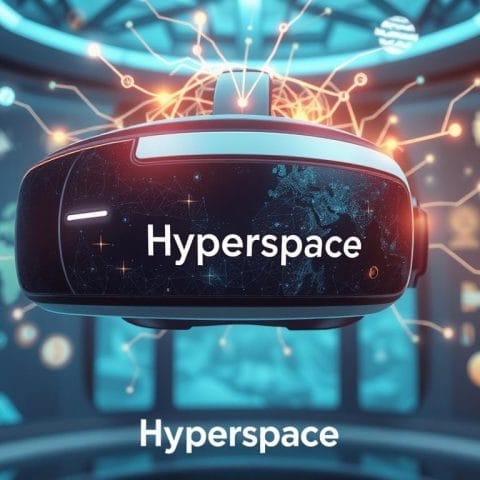In today’s fast-changing business world, companies are looking for new ways to improve their teams. Hyperspace, a top name in AI solutions, is changing team training with its advanced AI-driven immersive simulations. This new method mixes exciting virtual reality (VR) with AI, making learning fun and effective.
Hyperspace’s simulations use smart AI avatars that act like real people. They can change how they act based on the situation and even control the environment. These tools help teams learn important skills like working together and solving problems in a safe space.
Key Takeaways
- AI-driven immersive simulations revolutionize team dynamics training, making it a game-changer for workforce development.
- Hyperspace’s solutions feature autonomous AI avatars with natural interactions, context-aware responses, and dynamic adaptation capabilities.
- These immersive simulations create a “sandbox” environment for skills development, allowing teams to practice critical soft skills without impacting real-world operations.
- The integration of AI and VR technologies enables personalized learning, real-time feedback, and measurable training outcomes.
- Hyperspace’s innovative approach moves beyond traditional L&D methods to create a dynamic learning environment that drives tangible results.
Understanding AI in Team Dynamics Training

Organizations are now using AI to improve team training. This new method uses advanced algorithms to make learning experiences fit each team’s needs. It’s a personalized and adaptive way to train.
What is AI in Team Training?
AI in team training uses artificial intelligence to create interactive simulations. These simulations mimic real-world situations. They help teams practice important skills like emotional intelligence training, team communication skills, and leadership development safely.
Importance of Team Dynamics
Good team dynamics are key to a company’s success. They lead to better collaboration, decision-making, and efficiency. AI training helps teams develop these skills, making them more effective together.
Immersive Simulations Explained
Immersive simulations are at the core of AI team training. They use virtual reality and AI to create engaging scenarios. Teams practice skills in a safe space, getting feedback to improve.
“By 2027, over 60% of employers will prioritize dynamic, adaptive learning environments to develop their teams.”- Deloitte Insights
Benefits of Using AI for Training Teams

Using AI in team training opens up new possibilities. It brings better learning experiences and real-time feedback. These are just a few of the many benefits AI offers.
Enhanced Learning Experiences
AI makes team training more personal and engaging. It tailors content to fit each person’s needs and learning style. This way, learning is more effective and enjoyable.
Real-Time Feedback and Adaptation
AI gives instant feedback and adjusts training as needed. It spots skill gaps and guides learners to improve. This makes learning faster and more effective.
Boosting Team Cohesion
AI simulations help teams work better together. They focus on important topics like conflict resolution strategies and diversity and inclusion initiatives. These sessions improve teamwork and help teams grow together.
| Benefit | Impact |
|---|---|
| Enhanced Learning Experiences | Personalized, engaging content that maximizes knowledge retention and skill development |
| Real-Time Feedback and Adaptation | Efficient and effective skill-building through dynamic, targeted guidance |
| Boosting Team Cohesion | Customized simulations that address organizational needs and strengthen team unity |
“AI-powered team training is a game-changer, transforming the way organizations develop their most valuable asset – their people.”
How Immersive Simulations Work
Immersive simulations are changing how teams learn to work together well. They use new tech like virtual reality (VR), augmented reality (AR), and artificial intelligence (AI). This makes learning fun and real.
The Technology Behind the Simulations
VR and AR are key in immersive simulations. They let learners dive into virtual worlds. AI adds smart avatars and feedback, making it feel more natural.
This mix lets teams practice without fear of mistakes. It’s a safe space to get better.
Types of Simulations Available
- Sales and business development scenarios that enable representatives to hone their objection handling and negotiation abilities
- Mandatory training and onboarding experiences that prioritize employee safety and compliance
- Leadership development programs that challenge participants to make critical decisions and manage crises
User Experience in Immersive Training
The experience in immersive training is designed to be engaging. It has easy-to-use interfaces and clear instructions. This lets learners focus on the task without tech issues.
Adding choices and consequences in the simulations helps learners think critically. It makes learning deeper and more meaningful.
Immersive simulations help teams learn the skills they need for today’s fast-paced business world. They bridge the gap between learning and doing.
“Simulation-based learning has shown to be more practical and align closer to learners’ real-world job requirements, enhances engagement rates, and ensures relevant learning outcomes.”
Implementing AI in Team Training Programs
Adding AI to team training can change how companies teach and check their workers. With virtual reality simulations powered by AI, teams can learn in a way that feels real. This helps them make better decisions and work together more effectively.
Steps to Integrate AI in Training
- First, figure out what training your team needs most and where AI can help the most.
- Then, pick an AI tool that lets you create your own simulations easily, like Bright Software.
- Next, add the AI tool to your training setup so it works smoothly with what you already have.
- Make sure your team knows how to use the AI tools well by giving them good training.
- Keep an eye on how well the AI training is working and use that info to make your training better.
Choosing the Right Immersive Simulation Tool
When picking a simulation tool, think about how easy it is to use, how well it fits with your systems, and how customizable it is. Bright Software, for example, has tools that let L&D teams make training fast and specific to their needs.
Measuring Training Effectiveness
It’s important to see how well your AI training is working. AI simulations give lots of data on how learners do, helping you see what’s working and what’s not. This way, you can make your training better and show its value to your company.
“Learners benefit from engaging simulations that replicate real-world scenarios, enhance their decision-making skills, and conversational abilities.”
– Bright Software
Case Studies of Successful AI Training
AI-driven team training has shown its power in many industries. Success stories highlight how immersive simulations change training. They improve teamwork, emotional intelligence, and leadership.
Enhancing Communication at Northern Trains
Northern Trains in the UK wanted better communication among train drivers. They used AI simulations for training. This helped drivers practice teamwork in real-life scenarios.
Drivers learned to communicate better and understand their roles. This made them work together more effectively.
Boosting Problem-Solving Skills at Grenoble Business School
Grenoble Business School used a 9-hour virtual simulation for teaching. It focused on sustainable development. The AI-powered experience made students solve complex problems together.
This training improved their critical thinking and decision-making. The AI gave feedback in real-time, helping students get better at solving problems.
Developing Leadership at Harvard University
Harvard University’s language course used AI simulations. Students created virtual characters. This improved their language skills and emotional intelligence.
By playing different roles, students learned about communication and leadership. They understood how to adapt their leadership in different situations.
These examples show AI’s value in team training. It helps with problem-solving and emotional intelligence. As AI becomes more common in training, teams will see big improvements.
Challenges of Implementing AI in Team Training
Businesses are trying to make their team training better by using AI. AI can help a lot, but there are also challenges. They need to deal with resistance to change and technical issues to keep everyone engaged and successful.
Resistance to Change
One big challenge is when employees don’t want to change from old training methods. To overcome this, it’s important to explain how AI can improve team communication skills and leadership development. Giving support and training on new tech can make the transition smoother and encourage learning.
Technical Barriers
There can also be technical problems, like not being able to use AI with current systems. It’s key to make sure AI tools work well and are easy to use. Companies need to invest in the right tech and support to solve these issues.
Ensuring Continuous Engagement
Keeping teams interested in training is another big challenge. AI training needs to be fun and tailored to each person. Making updates based on feedback and results can keep everyone excited and motivated.
To overcome these challenges, a complete plan is needed. This includes clear communication, technical help, and a focus on learning every day. By tackling these issues, companies can make the most of AI in training and see big improvements in team communication skills and leadership development.
| Challenge | Strategies for Overcoming |
|---|---|
| Resistance to Change |
|
| Technical Barriers |
|
| Ensuring Continuous Engagement |
|
“The key to successful AI integration in team training is to address the challenges head-on, fostering a culture of continuous learning and development.”
Future Trends in AI and Team Dynamics
Team training is changing fast, thanks to artificial intelligence (AI) and virtual reality (VR). These new tools will make virtual reality simulations and cross-functional teamwork training better. They will help teams get ready for today’s work world.
Advancements in AI Technology
Natural language processing (NLP) and machine learning are getting better fast. This means virtual reality simulations can be more like real life. Team members can talk and act like they do in real situations.
This makes learning more real and useful. A McKinsey report shows how important this is.
Predictions for Team Training Methods
Team training will soon be more tailored to each person. AI will help make learning fit each person’s style and speed. This way, everyone learns better and faster.
Reports from PwC and Deloitte say this approach works well. It improves learning and soft skills a lot.
The Role of Virtual Reality
Virtual reality will become even more important for team training. It creates a safe space for teams to practice and learn. They can try things out without the risks of real life.
VR, with AI, makes learning more engaging and personal. It helps teams feel more confident and connected to what they’re learning.
As AI and VR keep getting better, team training will change a lot. It will be more engaging, personal, and useful for real life. This will help teams succeed in today’s fast-changing business world.
“By 2021, VR-trained employees learn four times faster than in classrooms, experience a 275% boost in confidence applying skills, and have a 3.75 times stronger emotional connection to content.”
Customization in Immersive Simulations
In the world of agile team management and conflict resolution, customization is key. AI-driven immersive simulations can be tailored to meet the unique needs of teams. This makes scenarios relevant to their industry and daily work.
Tailoring Training to Team Needs
Immersive simulations are great because they can be adjusted for each team. With AI tools like Bright Software’s, teams can focus on their specific skills and communication styles. This makes learning more engaging and useful for real-life situations.
Creating Scenarios Relevant to Industries
Immersive simulations are at their best when they reflect real industry challenges. For example, a sales negotiation scenario for a pharmaceutical company or a crisis management simulation for finance. These scenarios help employees learn skills they can use every day, making training more effective.
Evaluating Employee Performance
Customization also means evaluating employee performance better. AI analytics in these simulations give insights into how individuals and teams work. This helps identify areas for improvement and supports better decision-making and problem-solving.
“Integrating simulations into corporate training curricula improves decision-making skills and boosts overall job performance.”
By using customization in immersive simulations, teams can reach their full capacity. This leads to a culture of continuous learning, agile management, and better conflict resolution.
Building a Supportive Learning Environment
Creating a supportive learning environment is key for AI team training success. It’s about building trust and openness among team members. It also means encouraging risk-taking in safe simulations and supporting them every step of the way.
AI simulations can help with diversity and inclusion initiatives, making the workplace more welcoming. Support can include AI coaching, peer feedback, and regular check-ins. These help improve team communication skills and overall performance.
Cultivating Openness and Trust
Building a culture of openness and trust is essential for team training. When team members feel safe sharing their ideas, they’re more likely to participate fully. Simulations offer a safe space for trying new things without fear of failure.
Encouraging Risk-Taking in Simulations
Risk-taking is vital for learning and growth. Simulations should push team members to try new approaches. This helps develop a growth mindset and enhances problem-solving abilities.
Providing Ongoing Support
Team training doesn’t stop after a simulation. Ongoing support, like AI coaching and regular feedback, is critical. It helps team members apply what they’ve learned, leading to better team performance.
“Immersive learning experiences can lead to better knowledge retention compared to traditional methods. Addressing challenges in immersive learning adoption requires careful planning, stakeholder buy-in, and ongoing support to ensure successful implementation.”
Best Practices for Trainers
AI-driven immersive simulations are changing team training. Trainers need to adjust their methods for the best results. Using interactive tech, like gamification and storytelling, grabs learners’ attention. It helps teach emotional intelligence training and collaborative problem-solving skills.
Debriefing sessions are also vital. They let trainees think about what they learned and how to get better. Trainers should lead these talks, encouraging everyone to share and learn from each other.
Keeping training up-to-date is key. This ensures it stays relevant with new trends and needs. By using the latest in AI and VR, trainers can make learning more impactful and tailored to today’s teams.
By following these tips, trainers can make the most of AI simulations. They create training that’s engaging, adapts to learners, and keeps getting better. This helps teams develop the skills they need to succeed.
“AI algorithms in VR learning scenarios can evolve based on learner responses, creating a more dynamic and interactive learning experience.”
Conclusion: The Future of Team Training with AI
The future of team training with AI is exciting. AI-driven immersive simulations can change how teams learn and work together. They offer better learning experiences, feedback, and improved team performance.
Summary of Key Benefits
AI-powered immersive simulations bring many benefits. They make learning more engaging and tailored to each person. Teams can practice in a safe space, learning from mistakes.
They also provide real-time feedback and help employees keep up with new skills. This is key in today’s fast-changing world.
The Importance of Adaptation
Being able to adapt quickly is critical today. As AI and virtual reality improve, so will team training. Companies using these tools will have a workforce ready for the future.
Encouragement to Embrace Innovative Training Tools
AI and immersive simulations are changing team training. They make learning continuous and effective. It’s time for companies to use these tools to stay ahead.
This approach will help employees grow and adapt. The future of team training with AI is here, full of possibilities.
FAQ
Q: What is AI in team training?
A: AI in team training uses advanced algorithms for personalized learning. It aims to improve teamwork through immersive simulations that mimic real-life situations.
Q: Why is team dynamics important?
A: Team dynamics are key to a company’s success. They help teams work together better and more efficiently. Virtual reality and AI make training fun and interactive, helping teams practice without risk.
Q: How do immersive simulations work?
A: Immersive simulations use tech like virtual reality and AI to create real training environments. They range from simple scenarios to complex virtual worlds. This allows teams to practice teamwork and management skills.
Q: What are the benefits of using AI for team training?
A: AI in team training offers many benefits. It makes learning more engaging and personalized. It also provides real-time feedback and helps teams work better together.
Q: How can organizations implement AI in team training programs?
A: To use AI in team training, first assess your training needs. Then, choose the right AI tools and integrate them into your training plans. It’s important to measure how well the training works.
Q: What are some successful case studies of AI-driven team training?
A: AI-driven team training has shown great results in many fields. It has improved problem-solving, communication, and language skills. It has also increased engagement.
Q: What are the challenges of implementing AI in team training?
A: Challenges include resistance to change and technical issues. It’s also hard to keep everyone engaged. Overcoming these needs clear communication, technical support, and a culture that values learning.
Q: What are the future trends in AI and team dynamics?
A: Future trends include better natural language processing and more personalized learning. Virtual reality will play a bigger role in training. These advancements will make teamwork training even more effective.
Q: How can immersive simulations be customized for specific team needs?
A: AI-driven simulations can be tailored to meet specific team needs. They can create scenarios that address unique challenges. Tools like Bright Software’s platform help create customized AI models.
Q: What is the importance of creating a supportive learning environment for AI-driven team training?
A: A supportive learning environment is key for AI-driven team training. It involves building trust and encouraging risk-taking. Ongoing support is also important for success.
Q: What are the best practices for trainers using AI-driven simulations?
A: Best practices include using engaging training techniques and facilitating debriefing sessions. Trainers should also keep training content up-to-date with industry trends.





